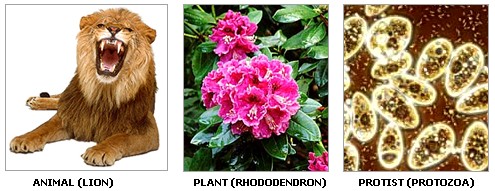DK Nature: Life On Earth
Planet Earth is home to trillions of organisms (living things), including animals and plants. They are found on land, in lakes, rivers, and oceans, as well as in the air. Scientists use CLASSIFICATION to show how different species, or types, of organisms are related.
All organisms need food for the energy required to live and grow. They all excrete (get rid of) waste products, and detect changes in their surroundings and respond to them. All living organisms follow a LIFE CYCLE of growth and development, reproduction, and death.
Sunlight is essential for life on Earth to exist. Plants use energy from sunlight to convert water and carbon dioxide gas into food. This releases essential, life-giving oxygen into the atmosphere. Virtually all other organisms rely on plants for energy to keep them alive. Even meat-eaters indirectly absorb vegetation from their plant-eating prey.
Earth’s rotation every 24 hours produces day and night. Some animals are active in the daytime, others at night. Without sunlight, plants stop making food and releasing oxygen. The annual movement of Earth around the Sun creates the seasons. Living things are more active in spring and summer.
Every living thing goes through a sequence of changes called its life cycle. Initially it grows and develops, gradually changing shape and getting larger. Once it is fully mature, it reproduces. Finally, it dies, and is replaced by its offspring.
Elephants can live to the age of 70, and humans can live for more than 100 years. Some giant tortoises live for more than 150 years, but certain plants live for much, much longer. The Californian bristlecone pine tree is thought to live to 4,900 years old, and the Californian creosote bush may be 12,000 years old.
Annual plants, such as sunflowers, live and die within one year, but their seeds survive the winter. Biennial plants, such as carrots, flower and produce seeds in their second year and then die. Perennial plants, including oak trees, live for several years—some flower yearly, some only once in their life cycle.
Scientists use classification to name living organisms. They sort them into groups by looking for any similarities or differences that indicate how closely related they are.
Organisms are sorted into groups ordered by size. The smallest, the species, contains organisms that breed together. Related species form a genus; several genera make a family. Linked families form an order; several orders make a class. A phylum contains a few classes. Phyla make up the largest group, the kingdom.
Organisms are divided into five kingdoms. Monerans include simple, single-celled organisms such as bacteria. Protists are mostly single-celled and include protozoa and algae. Fungi include mushrooms and molds. Plants include flowers, trees, and ferns. Animals include lions, lizards, and lice.

